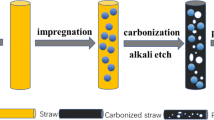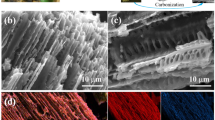Abstract
Renewable biomass has attracted great attention for the production of biooil, biogas, and biochar, a carbon residual applicable for carbon sequestration and environmental remediation. Rice straw is one of the most common biomasses among agricultural wastes in South Korea. As part of our advanced and environmentally friendly research, we applied biochar derived from rice straw as the anode material for lithium-ion batteries (LIBs). Porous carbons with a high surface area were prepared from rice straw. Such porous carbons have exhibited particularly large reversible capacity and hence proven to be a candidate anode material for high-rate and high-capacity LIBs. Rice straw-derived biochars were synthesized at four different temperatures: 400, 550, 700, and 900 °C. The surface was modified by using HCl and H2O2 on the 550 °C biochar in order to increase the surface area. The resulting biochar was characterized by X-ray diffraction (XRD) and field-emission scanning electron microscopy (FE-SEM). The surface area was measured by Brunauer–Emmett–Teller (BET) method. The electrochemical characterizations were investigated by galvanostatic charge–discharge (CD) curves, cyclic voltammetry (CV), and electrochemical impedance spectroscopy (EIS). All samples exhibited reversible capacities of below 200 mAh g−1. The surface-modified biochars exhibited improved cycle performance. Surface modification using HCl showed better cycle performance than H2O2. However, the capacities of the treated 550 °C biochar were similar to those of non-surface-modified biochar.






Similar content being viewed by others
References
Akihiro M, Katsuhisa T, Hiroyuki F, Takahiro K (1995) Charge-discharge characteristics of the mesocarbon miocrobeads heat-treated at different temperatures. J Electrochem Soc 142:1041–1046
Aurbach D, Levi MD, Levi E, Teller H, Markovsky B, Salitra G, Heider U, Heider L (1998) Common electroanalytical behavior of Li intercalation processes into graphite and transition metal oxides. J Electrochem Soc 145:3024–3034
Aurbach D, Levi MD, Gamulski K, Markovsky B, Salitra G, Levi E, Heider U, Heider L, Oesten R (1999) Capacity fading of LixMn2O4 spinel electrodes studied by XRD and LixMn2O4 electroanalytical techniques. J Power Sources 81–82:472–479
Azargohar R, Dalai A (2006) Biochar as a precursor of activated carbon. In: Twenty-seventh symposium on biotechnology for fuels and chemicals. Springer, Berlin pp 762–773
Chan KY, Van Zwieten L, Meszaros I, Downie A, Joseph S (2007) Agronomic values of greenwaste biochar as a soil amendment. Aust J Soil Res 45:629–634
Chan YK, Van Zwieten L, Meszaros I, Downie A, Joseph S (2008) Using poultry litter biochars as soil amendments. Aust J Soil Res 46:437–444
Chia-Chin C (2007) Nano-tin oxide/tin particles on a graphite surface as an anode material for lithium-ion batteries. J Phys Chem 111:16423–16427
Demirbas A (2004) Effects of temperature and particle size on bio-char yield from pyrolysis of agricultural residues. J Anal Appl Pyrolysis 72:243–248
Downie A, Klatt P, Downie R, Munroe P (2007) Slow pyrolysis: Australian demonstration plant successful on multifeed stocks. In: Bioenergy 2007 Conference. Jyvaskyla, Finland
Feng Z, Kai-Xue W, Guo-Dong L, Jie-Sheng C (2009) Hierarchical porous carbon derived from rice straw for lithium ion batteries with high-rate performance. Electrochem Commun 11:130–133
Genqiang Z, Le Y, Hao Bin W, Hoster HE, Xiong W (2012) Formation of ZnMn2O4 ball-in-ball hollow microspheres as a high-performance anode for lithium-ion batteries. Adv Mater 24:4609–4613
Haoran Y, Lifang D, Yujie Q, Noriyuki K, Jiahuan T (2014) Nonactivated and activated biochar derived from bananas as alternative cathode catalyst in microbial fuel cells. Sci World J. doi:10.1155/2014/832850
Huggins T et al (2014) Biochar as a sustainable electrode material for electricity production in microbial fuel cells. Bioresour Technol 157:114–119
Ioannidou O, Zabaniotou A (2007) Agricultural residues as precursors for activated carbon production—a review. Renew Sust Energ Rev 11:1966–2005
Jian J, Jianhui Z, Wei A, Zhanxi F, Xiaonan S, Chenji Z, Jinping L, Zhang H, Ting Y (2014) Evolution of disposable bamboo chopsticks into uniform carbon fibers: a smart strategy to fabricate sustainable anodes for Li-ion batteries. Energy Environ Sci 7:2670–2679
Kun-lei H, Long Q, Rui Z, Zi-qi Y, Wei Z, Duo W, Wei Y, Chao W, Qing-jie F, Wu-xing Z, Yun-hui H (2014) Biomass derived hard carbon used as a high performance anode material for sodium ion batteries. J Mater Chem A 2:12733–12738
Laird DA, Brown RC, Amonette JE, Lehmann J (2009) Review of the pyrolysis platform for coproducing bio-oil and biochar. Biofuels Bioprod Biorefin 3:547–562
Lehmann J, Gaunt J, Rondon M (2006) Bio-char sequestration in terrestrial ecosystems—a review. Mitig Adapt Strateg Glob Chang 11:403–427
Lei W, Xiu L, Jianmin M, Qingzhi W, Xiaochuan D (2014) Non-activated, N, S-co-doped biochar derived from banana with superior capacitive properties. Sust Energ 2:39–43
Lifen X, Yuliang C, Jie X, Wei W, Libor K, Zimin N, Jun L (2012) High capacity, reversible alloying reactions in SnSb/C nanocomposites for Na-ion battery applications. Chem Commun 48:3321
Lima IM, Mcaloon AJ, Boateng AA (2008) Activated carbon from broiler litter: process description and cost of production. Biomass Bioenergy 32:568–572
Roberts AD, Suxi W, Xu L, Haifei Z (2014) Hierarchical porous nitrogen-rich carbon monoliths via ice-templating: high capacity and high-rate performance as lithium-ion battery anode materials. J Mater Chem A 2:17787–17796
Sebastian W, Takeshi H, Jurgen J, Philipp A (2011) Room-temperature sodium-ion batteries: improving the rate capability of carbon anode materials by templating strategies. Energy Environ Sci 4:3342
Selhan K, Turgay T, Suat U, Murat E (2008) Activated carbons from waste biomass by sulfuric acid activation and their use on methylene blue adsorption. Bioresour Technol 99:6214–6222
Shaju KM, Subba Rao GV, Chowdari BVR (2003) Li ion kinetic studies on spinel cathodes, Li(M1/6Mn11/6)O4 (M=Mn, Co, CoAl) by GITT and EIS. J Mater Chem 13:106–113
Van Zwieten L, Bhupinderpal-Singh, Joseph S, Kimber S, Cowie A, Chan Y (2009) Biochar reduces emissions of non-CO2 GHG from soil. In: Lehmann J, Joseph S (eds) Biochar for environmental management. Earthscan Publications Ltd. ISBN: 9781844076581, pp 227–249
Yanai Y, Toyota K, Okazaki M (2007) Effects of charcoal addition on N2O emissions from soil resulting from rewetting air-dried soil in short-term laboratory experiments. Soil Sci Plant Nutr 53:181–188
Yunhua X, Yujie Z, Yihang L, Chunsheng W (2013) Electrochemical performance of porous carbon/tin composite anodes for sodium-ion and lithium-ion batteries. Adv Energy Mater 3:128–133
Acknowledgments
This work was supported by the Priority Research Centers Program through the National Research Foundation of Korea (NRF) funded by the Ministry of Education (2009-0093818).
Author information
Authors and Affiliations
Corresponding authors
Additional information
Responsible editor: Philippe Garrigues
Rights and permissions
About this article
Cite this article
Ryu, DJ., Oh, RG., Seo, YD. et al. Recovery and electrochemical performance in lithium secondary batteries of biochar derived from rice straw. Environ Sci Pollut Res 22, 10405–10412 (2015). https://doi.org/10.1007/s11356-015-4348-3
Received:
Accepted:
Published:
Issue Date:
DOI: https://doi.org/10.1007/s11356-015-4348-3




